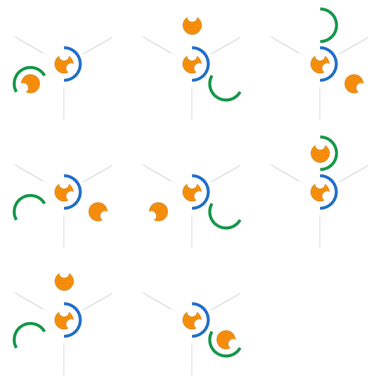How Far Are We from Intelligent Visual Deductive Reasoning?

86
🚀
Sign in to get full access
This summary was produced with help from an AI and may contain inaccuracies - check out the links to read the original source documents!
Related Papers
🚀

86
New!How Far Are We from Intelligent Visual Deductive Reasoning?
Yizhe Zhang, He Bai, Ruixiang Zhang, Jiatao Gu, Shuangfei Zhai, Josh Susskind, Navdeep Jaitly
Vision-Language Models (VLMs) have recently demonstrated incredible strides on diverse vision language tasks. We dig into vision-based deductive reasoning, a more sophisticated but less explored realm, and find previously unexposed blindspots in the current SOTA VLMs. Specifically, we leverage Raven's Progressive Matrices (RPMs), to assess VLMs' abilities to perform multi-hop relational and deductive reasoning relying solely on visual clues. We perform comprehensive evaluations of several popular VLMs employing standard strategies such as in-context learning, self-consistency, and Chain-of-thoughts (CoT) on three diverse datasets, including the Mensa IQ test, IntelligenceTest, and RAVEN. The results reveal that despite the impressive capabilities of LLMs in text-based reasoning, we are still far from achieving comparable proficiency in visual deductive reasoning. We found that certain standard strategies that are effective when applied to LLMs do not seamlessly translate to the challenges presented by visual reasoning tasks. A detailed analysis reveals that VLMs struggle to solve these tasks mainly because they are unable to perceive and comprehend multiple, confounding abstract patterns in RPM examples.
Read more10/2/2024


0
Enhancing Advanced Visual Reasoning Ability of Large Language Models
Zhiyuan Li, Dongnan Liu, Chaoyi Zhang, Heng Wang, Tengfei Xue, Weidong Cai
Recent advancements in Vision-Language (VL) research have sparked new benchmarks for complex visual reasoning, challenging models' advanced reasoning ability. Traditional Vision-Language Models (VLMs) perform well in visual perception tasks while struggling with complex reasoning scenarios. Conversely, Large Language Models (LLMs) demonstrate robust text reasoning capabilities; however, they lack visual acuity. To bridge this gap, we propose Complex Visual Reasoning Large Language Models (CVR-LLM), capitalizing on VLMs' visual perception proficiency and LLMs' extensive reasoning capability. Unlike recent multimodal large language models (MLLMs) that require a projection layer, our approach transforms images into detailed, context-aware descriptions using an iterative self-refinement loop and leverages LLMs' text knowledge for accurate predictions without extra training. We also introduce a novel multi-modal in-context learning (ICL) methodology to enhance LLMs' contextual understanding and reasoning. Additionally, we introduce Chain-of-Comparison (CoC), a step-by-step comparison technique enabling contrasting various aspects of predictions. Our CVR-LLM presents the first comprehensive study across a wide array of complex visual reasoning tasks and achieves SOTA performance among all.
Read more9/24/2024


0
What is the Visual Cognition Gap between Humans and Multimodal LLMs?
Xu Cao, Bolin Lai, Wenqian Ye, Yunsheng Ma, Joerg Heintz, Jintai Chen, Jianguo Cao, James M. Rehg
Recently, Multimodal Large Language Models (MLLMs) have shown great promise in language-guided perceptual tasks such as recognition, segmentation, and object detection. However, their effectiveness in addressing visual cognition problems that require high-level reasoning is not well-established. One such challenge is abstract visual reasoning (AVR) -- the cognitive ability to discern relationships among patterns in a set of images and extrapolate to predict subsequent patterns. This skill is crucial during the early neurodevelopmental stages of children. Inspired by the AVR tasks in Raven's Progressive Matrices (RPM) and Wechsler Intelligence Scale for Children (WISC), we propose a new dataset MaRs-VQA and a new benchmark VCog-Bench containing three datasets to evaluate the zero-shot AVR capability of MLLMs and compare their performance with existing human intelligent investigation. Our comparative experiments with different open-source and closed-source MLLMs on the VCog-Bench revealed a gap between MLLMs and human intelligence, highlighting the visual cognitive limitations of current MLLMs. We believe that the public release of VCog-Bench, consisting of MaRs-VQA, and the inference pipeline will drive progress toward the next generation of MLLMs with human-like visual cognition abilities.
Read more6/18/2024


0
Zero-Shot Visual Reasoning by Vision-Language Models: Benchmarking and Analysis
Aishik Nagar, Shantanu Jaiswal, Cheston Tan
Vision-language models (VLMs) have shown impressive zero- and few-shot performance on real-world visual question answering (VQA) benchmarks, alluding to their capabilities as visual reasoning engines. However, the benchmarks being used conflate pure visual reasoning with world knowledge, and also have questions that involve a limited number of reasoning steps. Thus, it remains unclear whether a VLM's apparent visual reasoning performance is due to its world knowledge, or due to actual visual reasoning capabilities. To clarify this ambiguity, we systematically benchmark and dissect the zero-shot visual reasoning capabilities of VLMs through synthetic datasets that require minimal world knowledge, and allow for analysis over a broad range of reasoning steps. We focus on two novel aspects of zero-shot visual reasoning: i) evaluating the impact of conveying scene information as either visual embeddings or purely textual scene descriptions to the underlying large language model (LLM) of the VLM, and ii) comparing the effectiveness of chain-of-thought prompting to standard prompting for zero-shot visual reasoning. We find that the underlying LLMs, when provided textual scene descriptions, consistently perform better compared to being provided visual embeddings. In particular, 18% higher accuracy is achieved on the PTR dataset. We also find that CoT prompting performs marginally better than standard prompting only for the comparatively large GPT-3.5-Turbo (175B) model, and does worse for smaller-scale models. This suggests the emergence of CoT abilities for visual reasoning in LLMs at larger scales even when world knowledge is limited. Overall, we find limitations in the abilities of VLMs and LLMs for more complex visual reasoning, and highlight the important role that LLMs can play in visual reasoning.
Read more9/4/2024